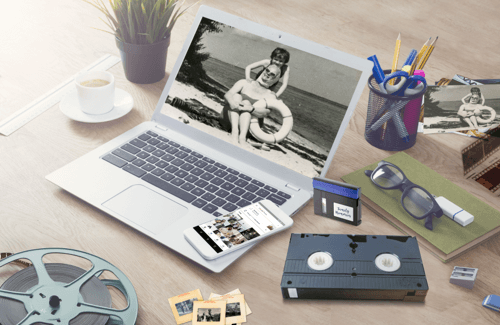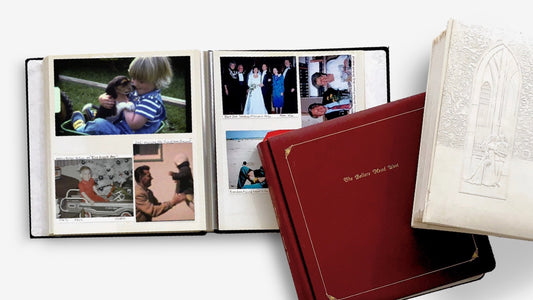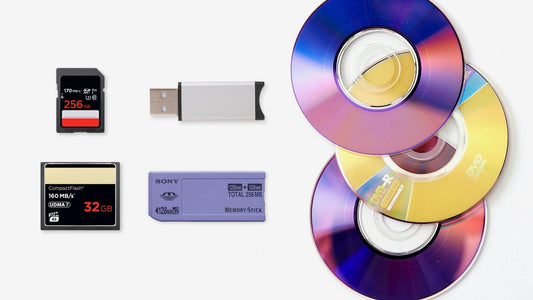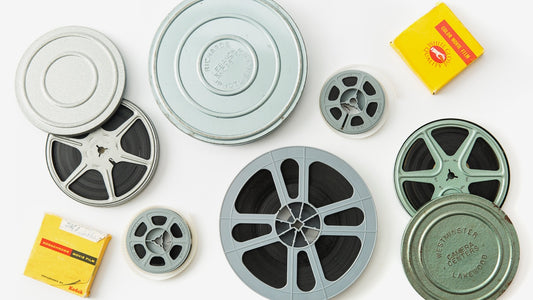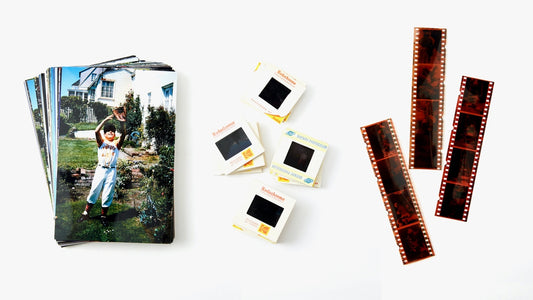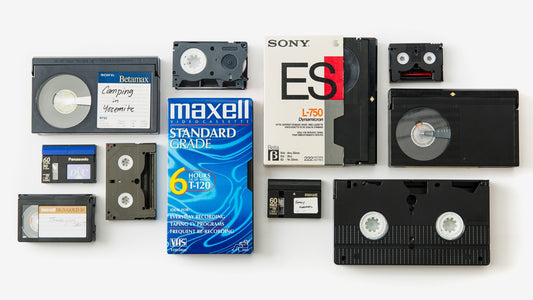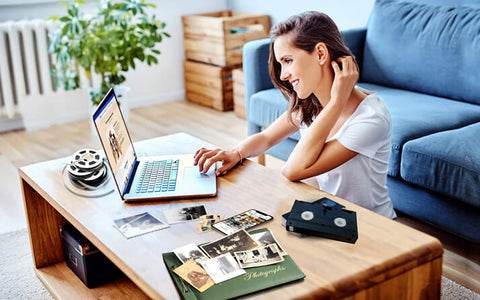Your family’s most cherished memories shouldn't be confined to a dusty box in the basement. Those wedding videos and childhood moments were meant to be watched and shared. The problem is that VHS tapes are stuck in the past, incompatible with the way we live today. Converting them to a digital format is about more than just preservation; it’s about liberation. It’s about being able to text a clip to your sibling, cast a holiday video to your TV, or create a highlight reel for an anniversary. Using a vhs to digital conversion service is the key that unlocks these memories, bringing them back into your life so you can enjoy and share them with the people you love, anytime and anywhere.
Key Takeaways
- Digitize to Stop the Clock on Degradation: Your VHS tapes weren't built to last and are physically breaking down with each passing year. Converting them to a digital format is the only way to halt this decay, preserving the quality of your footage before it's lost for good.
- Choose a Professional for Peace of Mind: While a DIY project is tempting, it risks poor-quality results and potential damage to your irreplaceable tapes. A professional service uses specialized equipment and expertise to ensure a safe, high-quality conversion, saving you time and worry.
- Protect Your New Digital Archive: Your job isn't done once the files are on your computer. Create a long-term safety net by organizing your videos into clear folders and following the 3-2-1 backup rule: three copies, on two different media types, with one stored off-site.
Why You Should Convert Your VHS Tapes to Digital
If you have a box of old VHS tapes tucked away in a closet or attic, you’re holding onto priceless family memories. Those tapes contain first steps, birthday parties, holiday gatherings, and moments you can never get back. But the tapes themselves are fading. Converting your VHS collection to a digital format is the single best way to protect those memories, make them easy to enjoy again, and share them with the people you love.
Beyond just preservation, digitizing your home movies breathes new life into them. Suddenly, a wedding video from 30 years ago isn't a bulky tape you can't watch anymore; it's a file you can edit, share on social media, or cast to your TV for a family movie night. It’s about taking your memories out of the box and bringing them back into your life. The process is simpler than you might think, and the peace of mind it brings is invaluable. Let's walk through exactly why making the switch from analog to digital is a decision you won't regret.
The Lifespan of a VHS Tape
Like all physical media, VHS tapes have an expiration date. The magnetic tape inside them degrades over time, with a typical lifespan of only 10 to 25 years. Heat, humidity, and dust can speed up this process, causing colors to fade, the audio to warp, and the picture to fill with static. Every time you play an old tape, you risk damaging it further. A professional video transfer stops this decay in its tracks, capturing the footage as it is today and preserving it in a stable digital format that won’t break down. It’s the best way to ensure your memories look and sound as good as possible for years to come.
Share and Watch Your Memories Anywhere
One of the best parts of digitizing your home movies is how easy it becomes to share them. You can’t exactly text a VHS tape to your sister who lives across the country. But once that footage is a digital file, you can send it in an email, post it for family on Facebook, or create a shared cloud album for everyone to enjoy. Imagine surprising your parents with a clip from their wedding on their anniversary or watching your own childhood birthday parties with your kids. Converting your tapes makes your memories portable and shareable, connecting generations no matter the distance.
Reclaim Your Shelf Space
Those stacks of VHS tapes take up a surprising amount of physical space. And let’s be honest, when was the last time you saw a VCR for sale? As the technology becomes more obsolete, the tapes become little more than clutter. Digitizing your collection lets you clear out those dusty boxes and reclaim valuable shelf or closet space. You can consolidate decades of memories onto a single, small USB drive or store them securely in the cloud. It’s a simple way to declutter your home while ensuring your most important memories are safer and more accessible than ever. You can even tackle other old media with a photo transfer to clear out even more space.
Protect Your Memories for the Future
Ultimately, converting your VHS tapes is about safeguarding your family’s legacy. These tapes are irreplaceable artifacts of your life, and they are at constant risk of being lost to decay, accidents, or disasters like a fire or flood. Creating a digital copy is a proactive step to protect those moments for your children and grandchildren. By choosing a film transfer or video conversion service, you’re not just making a backup; you’re creating a family archive that can be passed down through generations. It’s an investment in your family’s story, ensuring it can be told and retold for years to come.
How Professional Conversion Services Work
If the idea of tackling a box of old tapes feels overwhelming, you’re not alone. Handing your memories over to a professional service is a straightforward way to get the job done without the technical headaches. These services are designed to make the entire process simple, from sending in your tapes to receiving your new digital files.
The Professional Conversion Process
Think of a professional service as your personal memory preservation team. The process is simple: you pack up your VHS tapes, film reels, and photos and send them to the company. They take it from there, using specialized equipment to carefully turn your analog media into high-quality digital files. This saves your memories from the natural decay of old tapes and makes them accessible again. Once the video transfer is complete, they send your original tapes back to you along with your new digital copies, so you don’t have to part with the originals for good.
How Pros Ensure High-Quality Results
The real benefit of using a professional service is the expertise. Instead of you having to learn the ropes, trained technicians handle every step. At YesVideo, for example, every single tape is digitized by hand right here in the United States. This hands-on approach ensures each tape is treated with care, minimizing the risk of damage and maximizing the quality of the final video. Professionals use commercial-grade equipment that’s far more advanced than consumer-level converters, resulting in a clearer, more stable digital picture that truly honors your original footage.
Your Digital Format Options
Once your tapes are digitized, you get to decide how you want to receive your memories. Most services offer a few standard options to fit your needs. You can get your videos on a thumb drive, which is great for plugging directly into a computer or smart TV. Another popular choice is a set of DVDs for easy viewing on a standard DVD player. Many services also provide a digital download from a secure cloud account, giving you instant access to your files so you can save them and share them online with family and friends. This flexibility lets you choose the digital media format that works best for you.
Professional vs. DIY: A Quality Comparison
While a DIY project might seem tempting, it comes with risks. Attempting to convert tapes at home can lead to poor-quality video, audio sync issues, or even permanent damage to your irreplaceable tapes. It also requires a significant investment of your time and patience. Professional services eliminate these worries. They guarantee a higher-quality result because they use top-of-the-line equipment and have refined their process over thousands of hours. You get peace of mind knowing your memories are in safe hands and that the final product will be a clear, watchable, and lasting digital keepsake.
What Does Professional Conversion Cost?
The cost of professional conversion is an investment in protecting your family’s legacy. Generally, you can expect to pay between $15 and $35 per tape. The final price depends on the service you choose and the formats you select for your digital copies. For example, adding extra DVDs or getting your files on a USB drive might add a small fee. While it’s more expensive than a DIY kit upfront, you’re paying for expertise, quality, and security. When you consider the priceless nature of the memories on those tapes, having them professionally preserved is often well worth the cost.
A Look at the Top VHS to Digital Services
Once you’ve decided to hand your precious memories over to the pros, the next step is choosing the right service. It can feel like a big decision—after all, you’re trusting a company with one-of-a-kind tapes. The good news is that there are several reputable services that specialize in turning analog media into digital keepsakes, each with a slightly different approach. Think of it less like finding the single "best" service and more like finding the right fit for your specific needs, budget, and comfort level.
Some companies are known for their meticulous, hands-on process, while others are built around convenience, letting you drop off your tapes at a local store. Some offer a simple, all-in-one box, and others provide more a la carte options. We’ll walk through some of the most popular choices so you can get a clear picture of what each one offers. This will help you compare their processes, the formats they handle, and what you get back in the end. By understanding the landscape, you can confidently pick a partner to help you preserve your family’s history for generations to come.
YesVideo
As the trusted partner for major retailers, YesVideo has a long-standing reputation for quality and care. They handle a wide array of formats beyond just VHS, including film reels and photo albums. What sets them apart is their commitment to processing every order by hand in the USA, ensuring your memories are never outsourced. Their video transfer service includes a 60-day online backup, giving you plenty of time to download and share your newly digitized videos with family. With over 20 years of experience, they offer a secure and reliable option for preserving your most important moments.
Legacybox
Legacybox is known for its simple, mail-in kit system. You choose a box size based on how many items you want to digitize, fill it with your tapes, film, or photos, and send it in. They provide step-by-step tracking and updates throughout the process, so you always know where your memories are. Once digitized, you get your original media back along with your choice of a thumb drive, a DVD set, or a digital download. This straightforward approach makes it easy for anyone to get started without having to count or sort every single tape beforehand.
Kodak Digitizing
Leveraging a name that’s been synonymous with photography for over a century, Kodak Digitizing offers a modern service for your old media. They convert VHS tapes, film reels, photos, and even audio cassettes. The process is similar to other mail-in services: you send your media in their crush-proof box, and their technicians handle the conversion. You receive your digital files on a thumb drive, DVDs, or via a cloud download, plus all your original media returned safely. Their brand recognition provides a sense of trust and familiarity for many families looking to preserve their history.
Costco Photo Center
For Costco members, the in-house photo center offers a convenient way to digitize home movies and photos. In partnership with YesVideo, they provide a streamlined service where you can drop off your media at your local store. This eliminates the need to pack and ship your tapes yourself, which is a major plus for many. You can convert VHS tapes, film reels, photos, and slides, and you’ll receive your digital copies on a DVD or USB. It’s a great, accessible option if you’re already a frequent Costco shopper and prefer handling the drop-off in person.
Walmart Photo
Similar to Costco, Walmart Photo offers a media transfer service that makes digitization accessible and convenient. You can bring your VHS tapes and other media formats directly to the photo center in many of their stores. They convert your home movies to digital files and save them onto a USB drive, making it simple to plug in and watch on your computer or smart TV. This service is a practical choice for anyone who values the convenience of using a local, well-known retailer for their digitization needs, combining the task with their regular shopping trips.
CVS Photo
CVS Photo also provides a user-friendly video transfer service, making it another excellent option for those who prefer an in-person drop-off. By partnering with YesVideo, they ensure your memories are handled by experienced technicians. You can bring your VHS tapes, film, and photos to a local CVS, and they’ll take care of the rest. The focus is on making the process as simple as possible for the customer. You’ll get your originals back along with your new digital copies, giving you a convenient and reliable way to safeguard your family’s recorded moments.
Southtree
Southtree operates with a very similar model to its sister company, Legacybox, offering a mail-in service designed for simplicity. You send in your home videos, photos, and audio recordings, and their team digitizes everything for you. They emphasize a simple, all-in-one price structure for their kits, so you know the cost upfront. Like other services, they provide digital copies on a thumb drive, DVDs, or through a cloud download, and you always get your original media back. Their goal is to make it effortless to enjoy your memories on modern devices.
iMemories
iMemories focuses on creating a seamless digital viewing experience. After they digitize your VHS tapes and other media, they upload everything to a private online account. From there, you can easily view, share, and download your videos and photos from any device. They also offer the option to create custom DVDs or Blu-rays. A unique feature is their app, which makes it incredibly easy to watch your old home movies on your phone or tablet. This service is particularly appealing if your main goal is to easily share your memories online with family and friends.
How to Choose the Right Conversion Service
Handing over a box of your family’s most precious memories can feel like a huge leap of faith. You’re not just sending off old tapes; you’re entrusting someone with irreplaceable moments. That’s why picking the right service is about more than just price. It’s about finding a partner you can trust to handle your memories with the same care you would.
When you’re comparing options, it helps to have a checklist of what to look for. A reputable company will be transparent about its process and have clear answers to your questions. Think of it as an interview—you’re hiring them for the important job of preserving your family’s legacy. From their safety protocols to their customer support, every detail matters. Let’s walk through the key questions you should ask before making a decision.
How They Keep Your Tapes Safe
The first thing to consider is how a company will physically handle your media. Are your tapes processed by hand, or are they fed into an automated system? A service that takes a hands-on approach is more likely to catch potential issues, like a fragile tape that needs special attention. Look for companies that are open about their process. For example, YesVideo processes every order by hand in the USA, ensuring each tape, film reel, and photo gets individual attention. This level of care is essential when you’re dealing with one-of-a-kind items.
Do They Guarantee Their Work?
A company that stands behind its work will offer some form of a satisfaction guarantee. What happens if a tape is damaged or the digital quality isn’t what you expected? A trustworthy service will have a clear policy for these situations. Some companies even offer a monetary guarantee in the unlikely event your order is lost in transit. This isn't just about financial protection; it's a signal that the company values your memories and is confident in its ability to protect them throughout the video transfer process.
How Long Will It Take?
Digitizing home movies isn't an instant process, and that's a good thing. A quick turnaround might sound appealing, but quality work takes time. The process often involves careful inspection, cleaning, and real-time conversion to ensure the best possible digital copy. Most professional services take several weeks from the time they receive your order. Check the company’s website for their current estimated timeline. A transparent company will keep you updated with progress notifications, so you’re not left wondering about the status of your precious memories.
Protecting Your Tapes in Transit
It’s completely normal to feel a little nervous about mailing your tapes. A professional service understands this and will have a system in place to protect your order from the moment it leaves your hands. Look for companies that provide a sturdy, crush-proof shipping box and a pre-paid, trackable shipping label. Being able to follow your package’s journey to the processing facility and back provides incredible peace of mind. This is a standard feature for any service that prioritizes the safety of your photo transfer or film conversion.
What Kind of Support Do They Offer?
When you have questions, you want to know you can reach a real person. Before you commit, check out the company’s customer support options. Do they offer phone, email, or chat support? A strong indicator of a customer-focused company is proactive communication. Many services provide regular email updates or an online portal where you can track your order’s progress through each stage of the digitization process. This keeps you in the loop and shows that the company is actively managing your project with care and is available to help if you need it.
Are There Hidden Fees?
Pricing should be simple and straightforward. The last thing you want are surprise charges after your memories have already been sent in. Look for a company with a clear pricing model that’s easy to understand. For example, if you send in more tapes than you initially paid for, how is that handled? A reputable service will have a transparent policy for billing any extras. Before you order, read the fine print and make sure you understand exactly what’s included in the price, from the digital copies to the return of your original media.
Choosing the Right Digital Format
Once your precious tapes are digitized, the next step is deciding how you want to receive and store your newly preserved memories. This choice is just as important as the conversion itself, as it determines how you’ll watch, share, and protect your videos for years to come. You'll have a few options for storage, from physical media like DVDs and USBs to the convenience of the cloud. Thinking about how you plan to enjoy your home movies will help you pick the format that’s the perfect fit for your family.
DVD, USB, or Cloud: Which Is Best?
Choosing between a DVD, USB drive, or cloud storage really comes down to your comfort with technology and how you want to share your videos. DVDs are familiar and easy to pop into a player, making them a great gift for relatives who aren't tech-savvy. However, they can get scratched, and DVD players are becoming less common. A USB thumb drive is a fantastic, portable option that plugs directly into most modern TVs and computers. This makes it simple to copy and back up your files. The main downside is that they’re small and can be easy to misplace. Cloud storage gives you the ultimate flexibility, letting you access and share your memories from any device with an internet connection. With YesVideo, you get a private online account to view and share your memories, plus the option to add a USB or DVD set.
What File Format Should You Choose?
It’s a common hope that the digital version of a 30-year-old tape will look like it was filmed yesterday, but the conversion process can only preserve the quality of the original recording. That’s why choosing a high-quality, versatile file format is so important. The most common and recommended format is MP4. Think of it as the universal language for video—it plays nicely on almost any device, from your phone and computer to your smart TV. It also strikes the perfect balance between great video quality and a manageable file size. When you use a professional video transfer service, we take care of these technical details for you, ensuring your memories are saved in a format that’s built to last and easy to enjoy.
How to Store Your Digital Files for the Long Term
Your original VHS tapes have a limited lifespan; the magnetic tape inside begins to degrade after about 15 years. While digital files don't degrade in the same way, they aren't invincible. Hard drives can fail, and accidents can happen. To truly protect your memories for the future, it’s smart to have a long-term storage plan. A great rule of thumb is the 3-2-1 backup strategy: keep at least three copies of your files, on two different types of media, with one copy stored off-site. For example, you could keep one copy on your computer, a second on an external USB drive, and a third in the cloud. This ensures that even if one copy is lost or damaged, your cherished moments—whether from videotapes or old photo albums—are always safe.
The DIY Route: What You Need to Know
If you’re tech-savvy and love a good project, converting your own VHS tapes might seem like a rewarding weekend activity. It’s definitely an option, but it’s important to go in with your eyes open. The process is more involved than simply plugging a VCR into your computer. It requires specific equipment, software, and a good amount of patience to get right.
Before you pull those boxes of tapes out of the closet, let’s walk through what the DIY route really involves. From sourcing the right gear to troubleshooting common issues, you’ll need to be prepared for a hands-on process. This isn’t just about preserving memories; it’s about becoming a temporary media archivist. For many, the time and effort are worth it, but for others, the potential for frustration can outweigh the satisfaction. Knowing what’s ahead will help you decide if this is the right path for you and your precious home movies.
What Equipment Do You Need?
First things first, you’ll need a working VCR. Finding a reliable one can be a challenge, as most are decades old. For the best quality, you’ll want a model that has S-Video output, which can be expensive and hard to find. Next, you'll need an analog-to-digital video converter to connect the VCR to your computer, along with the right cables. Finally, you’ll need software to capture and edit the video. While some converters come with basic software, you might need to invest in a more robust program to edit, color-correct, and export your final digital files. Sourcing all this gear can quickly become a project in itself.
The Tech Skills Required
Once you have the equipment, you’ll need to get it all working together. This involves installing drivers for your video converter, configuring the capture software, and understanding settings like resolution and bitrates to get a quality result. DIY VHS digitization can be a technical process, and without the right know-how, you risk getting poor-quality video, audio sync issues, or even damaging your fragile tapes. It requires a certain comfort level with troubleshooting tech issues, as it’s rarely a simple plug-and-play operation. If you’re not prepared to spend time tinkering with settings and resolving connection problems, the DIY route can quickly become frustrating.
Common Problems You Might Face
VHS tapes weren't made to last forever. One of the biggest challenges you'll face is the age and condition of the tapes themselves. Over time, the magnetic tape degrades, leading to color loss, distorted audio, and tracking errors that cause static and jitters in the picture. You might also find tapes with mold, brittleness, or physical damage that can jam and ruin your VCR. Professionals who handle video transfer have specialized cleaning and repair equipment to manage these issues, but for a DIY project, a damaged tape can bring everything to a halt and put your irreplaceable memories at risk.
The Hidden Costs of Going DIY
While doing it yourself might seem like the cheapest option, the costs can add up unexpectedly. A good-quality used VCR can cost over $100, a reliable analog-to-digital converter is another $50-$80, and video editing software can add to the bill. Beyond the hardware, the biggest hidden cost is your time. The hours spent researching equipment, setting it up, capturing footage in real-time, and editing can quickly become more valuable than the money you’d spend on a professional service. When you factor everything in, you might find that a trusted digitization service is more affordable than you think, especially for the peace of mind it provides.
How Much Time Does DIY Really Take?
Be prepared to set aside a significant amount of time. Converting tapes isn't a quick process; the video has to be captured in real-time. That means a two-hour tape will take at least two hours to digitize—and that’s before you factor in setup, troubleshooting, editing, and exporting. If you have a box of 10 tapes, you’re looking at a bare minimum of 20 hours of capture time alone. This doesn't account for any time spent fixing audio sync issues, color correcting faded footage, or trimming unwanted sections. For busy families, dedicating entire weekends to this process often isn't practical, which makes the time savings of a professional service a major advantage.
How to Prepare Your Tapes for Conversion
Sending your precious memories off to be digitized can feel like a big step, but a little preparation can make the entire process smooth and worry-free. Taking the time to get your tapes in order before you ship them ensures they arrive safely and that your final digital collection is organized and easy to enjoy. Think of it as the first step in rediscovering all those wonderful moments. By following these simple steps, you can hand over your collection with confidence, knowing you’ve done your part to protect your family’s history.
Check the Condition of Your Tapes
Before you pack up your tapes, give them a quick inspection. Over the years, VHS tapes can show signs of wear. Look for obvious issues like cracked plastic casings, visible mold or mildew, or tangled tape. Unfortunately, magnetic tapes have a finite lifetime before degradation occurs, so don't be surprised if they aren't in perfect condition. If you spot minor dust, you can gently wipe the cassette with a soft, dry cloth. For more serious problems like mold or a broken case, it’s best to leave the repairs to the experts. Professionals have the tools and experience to handle fragile tapes, giving you the best chance of recovering the footage.
Organize and Label Your Collection
Imagine getting your digital files back and knowing exactly what’s on each one. A little organization now will save you a ton of time later. Start by gathering all your tapes and deciding which ones you want to convert. If you have a lot, you might want to prioritize the most important ones first. As you go, create a simple labeling system. You can use a sticky note or a piece of masking tape on each cassette. Number them sequentially (1, 2, 3…) and jot down a brief description, like "Hawaii Vacation '98" or "Kids' First Christmas." Many services, including YesVideo, provide a welcome kit with barcodes to help you track each item you send.
Pack Your Tapes Securely
Your tapes are about to go on a journey, so you want to make sure they’re packed safely for the trip. Find a sturdy cardboard box that’s slightly larger than your collection. Line the bottom with cushioning material like bubble wrap or crumpled paper. Arrange your tapes snugly inside, filling any empty spaces with more padding to prevent them from shifting around during transit. The goal is to make sure they can’t slide or bump into each other. When you use a professional service like YesVideo, you’ll often receive a crush-proof box and a pre-paid shipping label, which takes the guesswork out of packing and gives you extra peace of mind.
Track Your Order from Start to Finish
We know that sending your one-of-a-kind memories through the mail can be stressful. That’s why choosing a service that keeps you informed is so important. Reputable companies provide detailed tracking every step of the way. You should receive email notifications when your package arrives at the facility, as it moves through the digitization process, and when your original tapes and new digital copies are shipped back to you. At YesVideo, we offer a complete tracking system so you can follow your order’s progress from start to finish. This transparency lets you relax, knowing your memories are being handled with care.
How to Care for Your New Digital Memories
Getting your home movies back in a digital format is such an exciting moment. All those memories, once trapped on aging tapes, are now free. But the journey doesn't end the moment you receive your files. The next step is all about making sure these digital keepsakes are organized, safe, and easy to enjoy for years to come. Think of it as creating a digital home for your family’s history. Taking a little time now to organize, share, and back up your videos will make reliving those moments so much simpler down the road. It’s the best way to ensure your newly preserved memories don’t just sit on a hard drive, but become a living part of your family's story again. This is where the real fun begins.
Tips for Organizing Your Digital Videos
One of the best parts of having digital files is how easy they are to organize. To avoid a digital shoebox situation, create a simple folder system on your computer. You could organize folders by year, and within each year, create subfolders for specific events like "1994 - Summer Vacation" or "1998 - Danny's 5th Birthday." Take a few minutes to rename the files, too. Instead of "MVI_001," try "Christmas_1992_OpeningGifts.mp4." This small step makes finding that one specific clip you're looking for a breeze. Starting with a high-quality video transfer gives you a clean slate to build your digital archive.
The Best Ways to Share Your Memories
Now that your memories are accessible, it's time to share them. You can finally watch them on modern devices like your phone, tablet, or smart TV—no VCR required! Sharing is simple, whether you're posting a funny throwback clip on social media or sending a private link to family members across the country. You could even start a new tradition, like a family movie night to watch old home videos together. It’s a wonderful way to connect different generations and share stories. This is just as true for old pictures; a photo transfer can bring forgotten family albums back into the conversation.
How to Back Up Your Files
Your digital memories are precious, so protecting them is key. A hard drive can fail and accidents happen, which is why having a backup plan is so important. A good rule of thumb is the 3-2-1 method: keep at least three copies of your files, on two different types of storage (like your computer and an external hard drive), with one copy stored off-site in the cloud. Services like Google Drive, Dropbox, or iCloud are great for this. While YesVideo keeps a copy of your order for 90 days as a safety net, setting up your own long-term backup system gives you ultimate peace of mind.
Options for Enhancing Your Videos
Your digitized videos are a direct copy of what was on the tapes, but you can still make them even better. Simple, user-friendly video editing software lets you trim away the shaky parts, combine your favorite clips into a highlight reel, or even add a new soundtrack. For older media like 8mm or 16mm reels, a professional film transfer is the best starting point, as experts use specialized equipment to capture the best possible quality from the delicate source material. This gives you a fantastic foundation to work with if you decide to get creative with your own edits.
Related Articles
- Best VHS Video to Digital Converters: Top Picks – YesVideo
- 8 Best Digitizing Services Reviewed for 2025 – YesVideo
- YesVideo's Video Conversion Service - VHS, Video8, & More
- Video Tape to Digital: DIY or Pro? Your Best Bet – YesVideo
- The Ultimate Guide to Convert Tapes to Digital – YesVideo
Frequently Asked Questions
My tapes are really old and don't look like they're in great shape. Is it still possible to convert them? It’s completely normal for tapes that are decades old to show some wear. You might see dust, faded labels, or even a bit of brittleness in the plastic casing. In many cases, the footage inside is still recoverable. Professional services have technicians who are trained to handle fragile media and use specialized equipment to carefully clean and play the tapes, giving you the best possible chance of saving those memories. While not every tape can be saved, you’d be surprised at what the experts can often salvage.
I'm worried about mailing my one-of-a-kind tapes. How do you keep them safe? This is probably the most common concern we hear, and it’s completely understandable. Reputable conversion companies have built their entire process around protecting your memories. They provide sturdy, crush-proof shipping boxes and pre-paid, trackable shipping labels so you can follow your package’s journey. Once your order arrives at the facility, it’s barcoded and tracked internally through every step of the process, from check-in to digitization to return shipping. This ensures your memories are accounted for from the moment they leave your hands until they are safely returned.
Why should I pay for a professional service when I could just do it myself? The DIY route can seem tempting, but it often comes with hidden costs in both time and money. You’d need to find a working VCR, buy the right conversion hardware and software, and then spend hours capturing each tape in real-time. The bigger issue is quality and risk. Without experience, it’s easy to end up with poor video quality or even damage your irreplaceable tapes. Paying for a professional service means you’re paying for expertise, high-end equipment that produces a better result, and the peace of mind that comes from knowing your memories are in safe hands.
Once my videos are digital, what's the easiest way to watch and share them with my family? This is the best part! Your memories are finally free from that old VCR. You can get your digital files on a USB drive, which you can plug directly into a smart TV or computer to watch instantly. Another popular option is a secure cloud account, which lets you download the videos and share a private link with family members anywhere in the world. This makes it incredibly simple to surprise your parents with an old wedding clip or watch your childhood birthday parties with your own kids.
What happens after the conversion? How do I make sure my new digital files don't get lost? Getting your digital files is the first step; protecting them for the long haul is the next. Digital files don't degrade like tapes, but hard drives can fail. The best practice is to keep at least three copies of your memories. You can save one copy on your computer, a second on an external hard drive that you store somewhere safe, and a third using a cloud storage service. This simple backup strategy ensures that no matter what happens to one device, your family’s story is always protected for future generations to enjoy.





